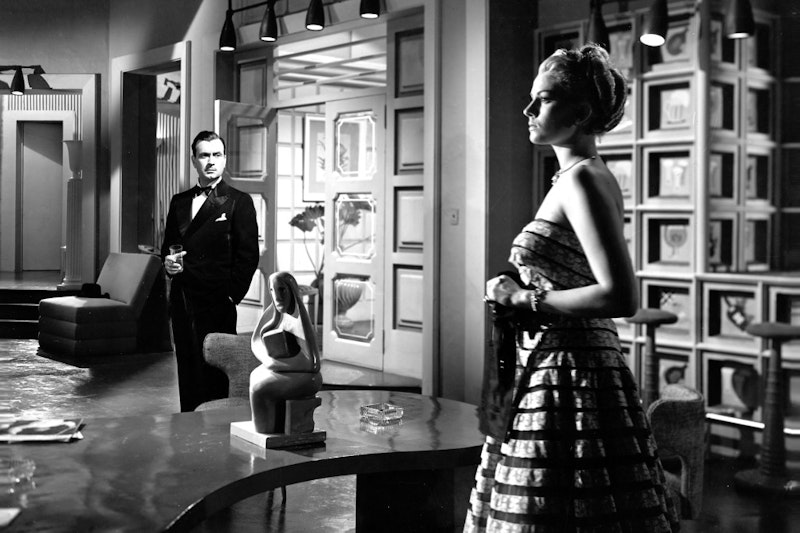The Criterion Channel recently began streaming a collection of Argentine noir movies from the 1950s, and as a result I’ve learned that Argentinians in the 1950s were remarkably good at making film noir. Consider the anthology film Never Open That Door.
Released in 1952, Never Open That Door is a two-part 85-minute feature from veteran Argentinian director Carlos Hugo Christensen adapting two stories by Cornell Woolrich; both parts are scripted by Spanish-born Alejandro Casona. A third adaptation was meant to be included in this movie, but ran long enough that it was released on its own.
The first story, “Somebody On the Phone,” follows wealthy Raul (Ángel Magaña), whose sister Luisa (Renée Dumas) is being blackmailed by parties unknown. Tragedy ensues, and Raul, following the clue of a ringing phone, thinks he knows who to blame. Events proceed with nightmarish inevitability up to a final twist.
“The Hummingbird Comes Home” introduces Rosa (Ilde Pirovano), a blind old woman whose son Daniel (Roberto Escalada) left her some time ago. He returns, with an accomplice (Luis Otero) in tow; Daniel’s grown up, and now knocks over jewelry stores. There’s considerable tension as Rosa figures this out, what she chooses to do, and then what Daniel chooses as a result. It’s even more of a nightmare than the first story, and if the ending’s weaker, the build’s just as inexorable.
The lack of fat in the scripts risks evoking old-fashioned TV anthologies like Alfred Hitchcock Presents. Stories are told concisely, with twists that aren’t surprising, and the genre conventions are obvious. But that’s not always bad. And both tales are told with stunning craft and feverish invention, so that what might’ve been conventional becomes rich and strange.
The lighting alone makes these films more visually compelling than a TV show. When Raul sees Luisa in a smoky club with a mysterious figure, the shadows are startling, powerful, and atmospheric; they create a sense of danger that sells the uncertainty and threat of the unknown man. The second part has an extended nighttime scene in the home of the old woman that masterfully creates an environment defined by gloom and darkness while still conveying action clearly.
The depth of field of even straightforward shots are subtly effective, so geographies are unobtrusively but thoroughly established. That’s particularly important in the second story, when Rosa moves through multiple levels of her large darkened house. It’s a little like 1967’s Wait Until Dark, which cast Audrey Hepburn as a blind woman who has to deal with criminals in her apartment, but the design of the space here is more complex and the play with light and shadow more subtle and much more effective.
Crucially, the places we see in this movie tell us about the characters who inhabit them. That’s important because expository dialogue is so minimal. We’re not told any more than we need to about the backgrounds of the characters. The sets and props and background details of their homes are what we know about them, and that’s enough to make them live.
Both stories have the power of nightmares, using their obvious narrative structures with an almost hallucinatory zeal. You see characters moving through contrived scenarios with a striking intensity that avoids earnestness through a sophistication of approach. It’s a sign of the performers’ skill, especially Magaña and Pirovano, that they’re able to craft real characters from simply-written genre constructions.
But Christensen and Casona keep the stories moving at a swift pace, and keep ratcheting up the tension. Characters are compelled to act because of who they are, and then to keep acting in dramatic ways. They’re pulled along by their own emotions as much as by the situations around them, and it’s gripping to watch.
There’s a latent power to the film, like a dream of noir images, with an intensity to the visuals beyond what the plot signifies. The film’s more irrational than most noirs. The conventions of the stories are pitched just far enough beyond the everyday that they’re feverish without being strained.
This doesn’t always pay off. The ending of the second story feels as though it’s missing some last kick of poetic justice. But even there the slight bafflement is the kind of bafflement you feel when a dream takes a turn that you realize, even as you’re dreaming it, doesn’t quite connect to what came before.
Noir’s often associated with the hard-boiled, the gritty and the realistic. This movie does something else. It uses the visual approach and narrative tropes of noir to build something more expressionistic. It uses genre not as a way of talking about naturalistic characters, but as a way of getting at what’s more profound and subconscious. It’s in that way surreal.
Consider the framing device of the film: it opens with a door, which a voice-over tells us separates civilized good from the evil of the jungle: “If you cross it, two hands will imprison you in anguish and pain. Never open that door!” The camera closes in on the door, which opens—to reveal a book with the first story, subtitled “Anguish.” The door returns to introduce the second, “Pain.”
It’s a creaky device, but it sets up the stories as morality plays. It tells us right from the start we’re not watching a film aiming at the merely real. The movie’s a vivid take on the noir, fusing the genre with the trappings of spiritual allegory to produce something delirious and shadow-drenched. Criterion’s done a real service streaming it, and the other films in the Argentine Noir collection.

